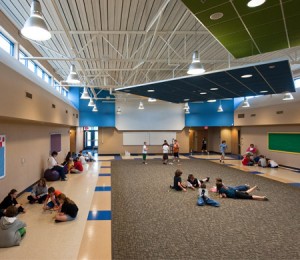A Paradigm Shift in the Learning Environment
Active Learning in Flexible Spaces
 It’s no secret that schools are shifting towards more immersive styles of teaching, utilizing active and flexible learning spaces. The traditional teaching methods are quickly evolving to integrate a variety of teaching styles
It’s no secret that schools are shifting towards more immersive styles of teaching, utilizing active and flexible learning spaces. The traditional teaching methods are quickly evolving to integrate a variety of teaching styles
beyond lectures that include group activities and peer to peer work. Research is consistently showing the learning advantages of flexible spaces and interactive teaching styles. The modern classroom is consequently integrating new components, from adjustable walls that can be opened to allow instructors to teach in larger group settings or across multiple classrooms, to desks and furniture that can be re-arranged to adapt to both individual learning approaches and group work. These flexible learning spaces allow for instructors to easily move between groups of students and provide real time feedback during their peer to peer interactions. The future of K-12 classrooms will allow for increased flexibility as teachers focus more heavily on project based learning and personalized approaches.
Growing Adoption of Educational Technologies
But of course, there is one other thing we all know is changing: technology. Classroom design and pedagogical approaches are increasingly utilizing technology to effectively deliver lessons. There continues to be a growing interaction between students and teachers as advancements in technology are integrated into the teaching environment. It is important to evaluate how future classrooms will be affected by the incorporation of technologies such as mobile devices, computers, interactive gaming technologies, and interactive white boards to ensure efficient and effective student and teacher collaboration. Instructors are integrating interactive technologies into their lesson plans, exploring ways of actively increasing engagement with students, and implementing new educational strategies. Advances in technology position schools to shift towards blended learning environments that incorporate innovative elements within the traditional teaching environments.
“Future Proofing” Educational Designs
So what does this mean for us? How do we design spaces that are not obsolete the minute construction is complete when we operate in an environment that is continually changing, adapting, and advancing? It is simple. We plan for change. The key to designing for the future is planning spaces that are not permanent, spaces that create flexible avenues for collaboration, socializing, and functionality. If we cannot predict the future, we can only predict that the future will change. So we must utilize classroom furniture that can be quickly moved, reconfigured, interchanged, and easily stored. We must design spaces with accessible outlets, power distribution and connectivity to allow for the continual integration of new technologies. And we must design open, flexible, and adaptable spaces that allow for change. We recognize that if we want to incorporate advanced and flexible designs, we must simply be flexible.
Categories:
Tags:
Contact Us
Learn more about our services and offerings.
